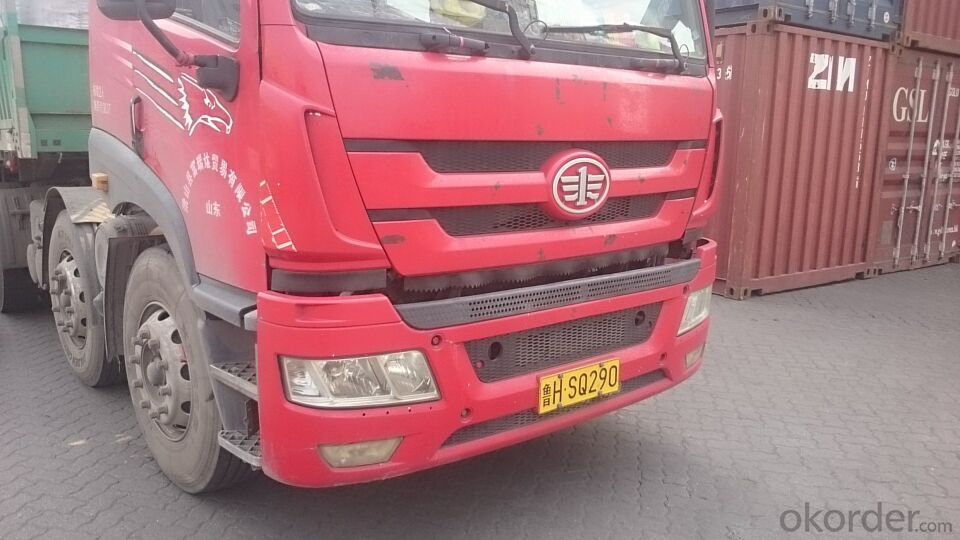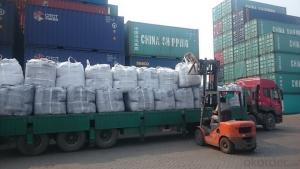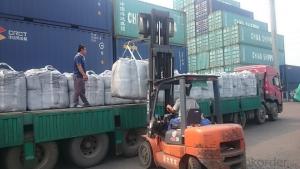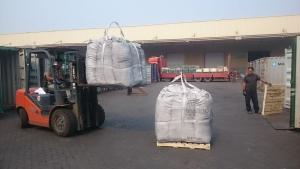Used in EAF as Charge Coke for Steel Plants with VM 1.5%max
- Loading Port:
- Tianjin
- Payment Terms:
- TT OR LC
- Min Order Qty:
- 21 m.t.
- Supply Capability:
- 6000 m.t./month
OKorder Service Pledge
OKorder Financial Service
You Might Also Like
Introduction:
Calcined anthracite can be called carbon additive, carbon raiser, recarburizer, injection coke, charging coke, gas calcined anthracite.
Carbon Additive/Calcined Anthracite Coal may substitute massively refinery coke or graphite. Meanwhile its cost is much less than the refinery coke and graphite. Carbon Additive is mainly used in electric steel ovens, water filtering, rust removal in shipbuilding and production of carbon material.
It has good characteristics with low ash, low resistivity, low sulphur, high carbon and high density. It is the best material for high quality carbon products. It is used as carbon additive in steel industry or fuel.
Features:
Best quality Taixi anthracite as raw materials through high temperature calcined at 800-1200 ℃ by the DC electric calciner with results in eliminating the moisture and volatile matter from Anthracite efficiently, improving the density and the electric conductivity and strengthening the mechanical strength and anti-oxidation, It has good characteristics with low ash, low resistivity, low carbon and high density. It is the best material for high quality carbon products, it is used as carbon additive in steel industry or fuel.
Specifications:
F.C.% | 95MIN | 94MIN | 93MIN | 92MIN | 90MIN | 85MIN | 84MIN |
ASH % | 4MAX | 5MAX | 6 MAX | 6.5MAX | 8.5MAX | 12MAX | 13MAX |
V.M.% | 1 MAX | 1MAX | 1.0MAX | 1.5MAX | 1.5MAX | 3 MAX | 3 MAX |
SULFUR % | 0.3MAX | 0.3MAX | 0.3MAX | 0.35MAX | 0.35MAX | 0.5MAX | 0.5MAX |
MOISTURE % | 0.5MAX | 0.5MAX | 0.5MAX | 0.5MAX | 0.5MAX | 1MAX | 1MAX |
Pictures




FAQ:
Packing:
(1). Waterproof jumbo bags: 800kgs~1100kgs/ bag according to different grain sizes;
(2). Waterproof PP woven bags / Paper bags: 5kg / 7.5kg / 12.5kg / 20kg / 25kg / 30kg / 50kg small bags;
(3). Small bags into jumbo bags: waterproof PP woven bags / paper bags in 800kg ~1100kg jumbo bags.
Payment terms
20% down payment and 80% against copy of B/L.
Workable LC at sight,
- Q: What are the impacts of carbon emissions on coral reefs?
- Coral reefs are significantly affected by carbon emissions, with one of the most notable consequences being ocean acidification. This occurs when excess carbon dioxide (CO2) from the atmosphere is absorbed, causing the ocean to become more acidic. As a result, coral reefs struggle to build and maintain their calcium carbonate skeletons, which are crucial for their structure and survival. Consequently, their growth rates decrease, and their resilience weakens, making them more susceptible to damage from storms, disease, and other stressors. Moreover, the increasing ocean temperatures caused by carbon emissions have led to widespread events of coral bleaching. When corals are exposed to prolonged high temperatures, they expel the symbiotic algae (zooxanthellae) that live within their tissues. These algae provide essential nutrients and vibrant colors to the corals. Without them, corals become pale or completely white, a phenomenon known as bleaching. While corals can recover if the stressors decrease, severe or prolonged bleaching can result in coral death and the subsequent degradation of the reef ecosystem. Additionally, carbon emissions contribute to the intensification of storms and other extreme weather events, posing a direct threat to coral reefs. Stronger storms physically damage the reefs, breaking their fragile structures and reducing their resilience. Moreover, the sediment runoff from land, often exacerbated by storms, smothers corals and hinders their ability to feed and grow. The impacts of carbon emissions on coral reefs are not only detrimental to the diverse marine ecosystems but also to the millions of people who rely on them for food, income, and coastal protection. Coral reefs support a wide range of marine life, provide livelihoods for many communities through fishing and tourism, and act as natural barriers against storm surge and coastal erosion. The degradation of coral reefs due to carbon emissions jeopardizes the livelihoods and well-being of these communities, as well as the overall health and biodiversity of our oceans. To address these impacts, it is crucial to reduce carbon emissions by transitioning to cleaner, renewable energy sources, promoting sustainable practices on land to minimize runoff and pollution, and implementing effective management and conservation measures to protect and restore coral reef ecosystems.
- Q: Glucose contains resveratrol (C14H12O3) to determine the mass ratio of resveratrol and carbon dioxide of the same quality as carbon dioxide
- They are x and y, containing carbon equal, according to the mass of an element = the mass of a compound * the elementMass fractionFor C14H12O3, the carbon mass fraction is C%=12*14/ (12*14+12+16*3) *100%=73.68%For CO2, the mass fraction of carbon is 12/ (12+16*2) =27.27%There is x *73.68%=y*27.27%So there's X: y =57:154
- Q: How can I see if a battery can be used to recharge it?Can not all carbon batteries charge?
- Final conclusion:Carbon batteries, alkaline batteries are not charged, the voltage is 1.5V, nickel cadmium batteries, nickel hydrogen batteries can charge voltage 1.2VPay special attention to the risk of leakage or explosion if you charge to a carbon battery or alkaline battery
- Q: What are the environmental impacts of burning fossil fuels?
- Burning fossil fuels has significant environmental impacts, including air pollution, greenhouse gas emissions, and climate change. When fossil fuels, such as coal, oil, and natural gas, are burned, they release harmful pollutants into the atmosphere, such as sulfur dioxide, nitrogen oxides, and carbon dioxide. These pollutants contribute to air pollution, smog formation, and respiratory issues. Additionally, carbon dioxide emissions from burning fossil fuels are the primary driver of global warming and climate change, leading to rising temperatures, sea-level rise, and extreme weather events. The extraction and transportation of fossil fuels also have environmental consequences, such as habitat destruction, water pollution, and the disruption of ecosystems. Therefore, reducing our reliance on fossil fuels and transitioning to cleaner, renewable energy sources is crucial for mitigating these environmental impacts.
- Q: What are the consequences of increased carbon emissions on human health?
- Increased carbon emissions have significant consequences on human health. One of the most immediate impacts is the deterioration of air quality. Carbon emissions contribute to the formation of harmful air pollutants, such as particulate matter, nitrogen oxides, and ground-level ozone. These pollutants can cause respiratory problems, such as asthma, bronchitis, and other chronic obstructive pulmonary diseases. They can also exacerbate existing respiratory conditions, leading to increased hospitalizations and premature deaths. Furthermore, carbon emissions contribute to the phenomenon of climate change, which has far-reaching effects on human health. Rising temperatures can exacerbate the occurrence and intensity of heatwaves, leading to heat-related illnesses and deaths. Heat stress also affects vulnerable populations, such as the elderly, children, and those with pre-existing health conditions. Climate change also impacts the spread of infectious diseases. Warmer temperatures and changing rainfall patterns can alter the distribution and behavior of disease-carrying vectors like mosquitoes and ticks. This can result in the increased transmission of vector-borne diseases, such as malaria, dengue fever, and Lyme disease. Additionally, climate change can disrupt food and water supplies, leading to malnutrition and an increased risk of waterborne diseases. Another consequence of carbon emissions is the increased occurrence of natural disasters, such as hurricanes, floods, and wildfires. These events can cause physical injuries, displacement, and mental health issues, such as post-traumatic stress disorder. The destruction of healthcare infrastructure during disasters also hampers access to necessary medical care, exacerbating health issues. It is important to note that the consequences of increased carbon emissions on human health disproportionately affect vulnerable populations, including low-income communities, indigenous communities, and developing countries. These groups often have limited access to healthcare, making them more susceptible to the health impacts of carbon emissions. In conclusion, increased carbon emissions have severe consequences on human health. From deteriorating air quality to the spread of infectious diseases and the occurrence of natural disasters, the impacts are wide-ranging and pose significant risks to individuals and communities. It is crucial to mitigate carbon emissions and invest in sustainable practices to safeguard human health and create a healthier and more sustainable future.
- Q: What are the environmental impacts of carbon emissions from industries?
- The environmental consequences resulting from industries' carbon emissions are significant and extensive. To begin with, carbon emissions contribute to the greenhouse effect, resulting in global warming and climate change. The excessive release of carbon dioxide and other greenhouse gases into the atmosphere traps heat, leading to a rise in the Earth's temperature. Consequently, polar ice caps melt, sea levels increase, and extreme weather events like hurricanes and droughts occur. These alterations disrupt ecosystems, cause biodiversity loss, and jeopardize the survival of various species. Furthermore, carbon emissions contribute to air pollution. Industries release not only carbon dioxide but also harmful pollutants like sulfur dioxide, nitrogen oxides, and particulate matter. These pollutants have adverse effects on human health, causing respiratory and cardiovascular problems, and even premature death. Additionally, they contribute to the creation of smog and acid rain, causing further harm to ecosystems and endangering plant and animal life. Moreover, carbon emissions from industries negatively impact water systems. When carbon dioxide dissolves in water, it forms carbonic acid, resulting in a decrease in pH levels and increased acidity. This acidification harms marine life, especially organisms with calcium carbonate shells or skeletons, such as coral reefs, shellfish, and plankton. The disruption of marine ecosystems can have a ripple effect on other species and disturb the food chain. Lastly, carbon emissions contribute to deforestation and habitat destruction. Industries often rely on fossil fuels for energy, leading to the clearing of forests to make way for mining or drilling operations. This destruction of natural habitats not only reduces biodiversity but also releases stored carbon from trees into the atmosphere, exacerbating the carbon emissions problem. To address these environmental impacts, industries must prioritize the reduction of carbon emissions. This can be achieved by adopting cleaner and more sustainable energy sources, implementing energy-efficient technologies, and enforcing stricter regulations and policies. Transitioning to renewable energy, improving industrial processes, and investing in carbon capture and storage technologies are vital steps toward mitigating the environmental consequences of industries' carbon emissions.
- Q: What is carbon coffee fiber?
- The carbon coffee fiber uses the coffee residue left after the coffee and is made into crystal by calcining, then ground into nanometer powder and added to the polyester fiber to produce a functional polyester staple, a coffee carbon fiber.
- Q: What are the impacts of carbon emissions on the stability of kelp forests?
- Carbon emissions have significant impacts on the stability of kelp forests. Increased carbon dioxide (CO2) levels in the atmosphere lead to ocean acidification, which has detrimental effects on kelp. As CO2 dissolves in seawater, it forms carbonic acid, lowering the pH of the ocean. This acidification inhibits the growth and development of kelp, making them more vulnerable to stressors and reducing their overall stability. Ocean acidification affects the physiology of kelp in several ways. It hampers their ability to take up essential nutrients, such as nitrogen and phosphorus, which are crucial for their growth. This nutrient limitation weakens the kelp, making them more susceptible to diseases, predation, and damage from storms. Additionally, acidified seawater can hinder the development of kelp spores, impairing their ability to reproduce and regenerate kelp forests. Furthermore, carbon emissions contribute to rising sea temperatures, which also have detrimental effects on kelp forests. As the climate warms, kelp may experience thermal stress, leading to reduced growth rates and increased mortality. Warmer waters can also favor the growth of harmful algae species, which can outcompete kelp for space and resources, further destabilizing kelp forests. The stability of kelp forests is crucial as they provide numerous ecosystem services. They act as important carbon sinks, absorbing and storing large amounts of carbon dioxide from the atmosphere. Kelp forests also provide habitat and nursery grounds for a wide variety of marine species, including commercially important fish and invertebrates. They help maintain the health and productivity of coastal ecosystems by reducing coastal erosion, improving water quality, and supporting biodiversity. To mitigate the impacts of carbon emissions on kelp forests, it is essential to reduce our carbon footprint by transitioning to cleaner and more sustainable energy sources. Additionally, protecting and restoring coastal habitats, including kelp forests, can enhance their resilience to climate change and other stressors. Implementing sustainable fishing practices and establishing marine protected areas can also help preserve and maintain the stability of kelp forests and the valuable ecosystem services they provide.
- Q: Rod box material, there is a kind of material called carbon fiber, who knows this material is good?
- Very good, carbon fiber is made of organic fiber after a series of heat treatment into, inorganic fiber with high performance carbon content is higher than 90%, is a new material with excellent mechanical properties, the intrinsic properties of natural carbon material with, and both the textile fiber soft processing, is a new generation of fiber. Carbon fiber is a new dual-use material for military and civilian use. It is the key material of technology intensive and politically sensitive. It is the only material that does not drop in the high temperature inert environment above 2000 degrees celsius. Carbon fiber steel accounted for less than 1/4, the tensile strength of composite is generally above 3500Mpa, is 7-9 times that of steel, carbon fiber has superior corrosion resistance, it can also be safe and sound in the dissolution of gold and platinum "aqua".
- Q: What are the different types of carbon-based composites?
- There exist various carbon-based composites, each possessing distinct properties and applications. Some commonly encountered types encompass carbon fiber reinforced polymers (CFRPs), carbon nanotube composites, and carbon fiber reinforced ceramics. Among these, CFRPs stand as the most renowned and extensively employed carbon-based composites. They feature carbon fibers embedded within a polymer matrix, such as epoxy resin. CFRPs exhibit a lightweight nature, coupled with exceptional strength and rigidity, rendering them ideal for industries where weight reduction and high strength prove essential, such as aerospace, automotive, and sporting goods. Carbon nanotube composites represent another category of carbon-based composites that have garnered substantial attention in recent years. Carbon nanotubes possess cylindrical structures comprising carbon atoms arranged in a hexagonal lattice. Upon incorporation into composite materials, they bolster mechanical, thermal, and electrical properties. Carbon nanotube composites hold potential applications across fields like electronics, energy storage, and structural materials. Carbon fiber reinforced ceramics combine the superior strength and rigidity of carbon fibers with the exceptional ability to resist high temperatures exhibited by ceramics. These composites widely find use in industries necessitating materials capable of withstanding extreme temperatures, such as aerospace, defense, and nuclear sectors. Carbon fiber reinforced ceramics offer an excellent balance encompassing strength, thermal stability, and low weight. Additional types of carbon-based composites encompass carbon fiber reinforced metals, wherein carbon fibers are embedded within a metal matrix, and graphene composites, which incorporate graphene sheets into a polymer or metal matrix. These composites offer distinct properties like high electrical conductivity, thermal stability, and mechanical strength, unveiling possibilities for applications in areas like electronics, energy storage, and structural materials. On the whole, carbon-based composites present a wide array of properties and applications, rendering them indispensable materials within various industries requiring lightweight, strong, and durable substances.
Send your message to us
Used in EAF as Charge Coke for Steel Plants with VM 1.5%max
- Loading Port:
- Tianjin
- Payment Terms:
- TT OR LC
- Min Order Qty:
- 21 m.t.
- Supply Capability:
- 6000 m.t./month
OKorder Service Pledge
OKorder Financial Service
Similar products
Hot products
Hot Searches


























